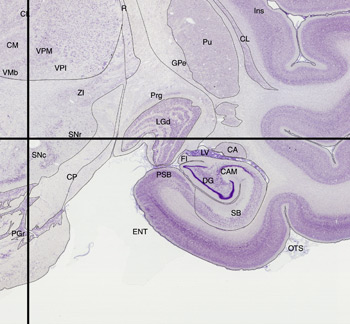The theoretical process of pattern completion has been ascribed to a region of the brain called the hippocampus. The name hippocampus comes from the fact that this region resembles a seahorse.
If you peer at a section of the hippocampus, it is arguably one of the most beautiful brain regions, it twists and curves like no other. It has two inter-locking structures: the dentate gyrus (which appears to bite the other structure) and the cornus ammonus (the horns of Ammon - the ancient Egyptian god).
The third field of the cornus ammonus (the CA3 region) contains a remarkable set of brain cells. Like the rest of the brain, the neurons in this region connect to many others, but they also produce a large number of connections to themselves.
Computational neuroscientists discovered that this self-connected-ness is a very useful feature in a neural network that can be used to memorise information. A lot of information can be stored in such a network and retrieved by the presentation of just a small fragment of the original information provided. This process is thought to be similar to the way we can remember a whole event from a small detail such as a name.
The spatialised pockets of images and sounds in our installation echo the anatomical arrangement of these networks of cells within the CA3 region. The installation reflects the idea that individual memories may sit in different regions of the hippocampus and that their positions may shift or alter over time.
If you peer at a section of the hippocampus, it is arguably one of the most beautiful brain regions, it twists and curves like no other. It has two inter-locking structures: the dentate gyrus (which appears to bite the other structure) and the cornus ammonus (the horns of Ammon - the ancient Egyptian god).
The third field of the cornus ammonus (the CA3 region) contains a remarkable set of brain cells. Like the rest of the brain, the neurons in this region connect to many others, but they also produce a large number of connections to themselves.
Computational neuroscientists discovered that this self-connected-ness is a very useful feature in a neural network that can be used to memorise information. A lot of information can be stored in such a network and retrieved by the presentation of just a small fragment of the original information provided. This process is thought to be similar to the way we can remember a whole event from a small detail such as a name.
The spatialised pockets of images and sounds in our installation echo the anatomical arrangement of these networks of cells within the CA3 region. The installation reflects the idea that individual memories may sit in different regions of the hippocampus and that their positions may shift or alter over time.

Image source: BrainMaps.org
